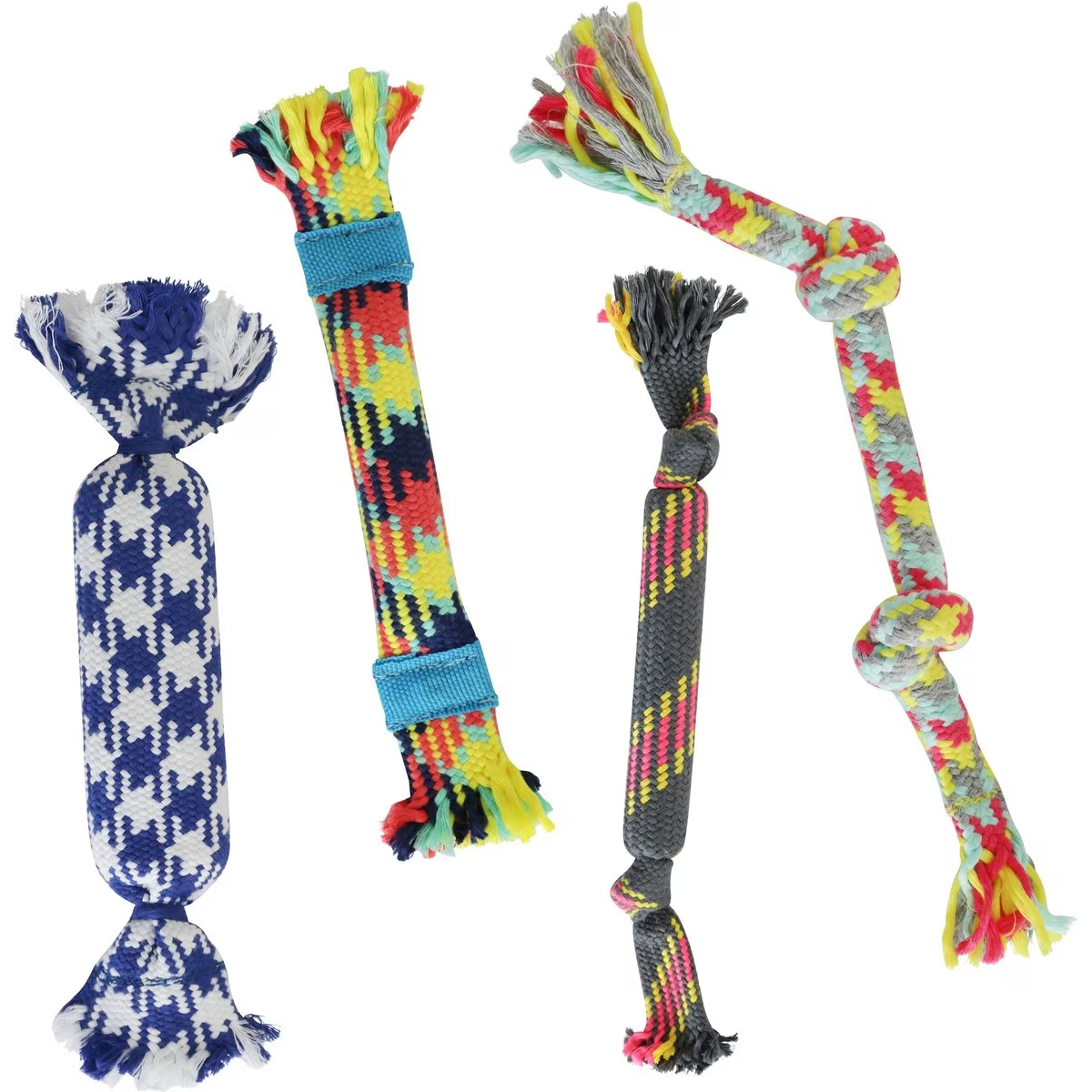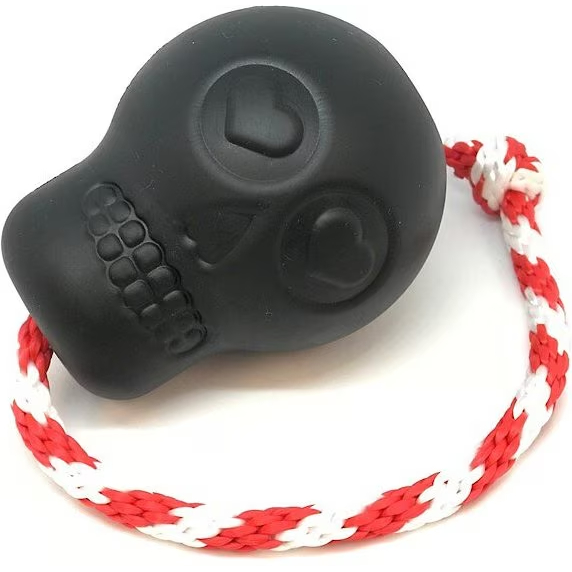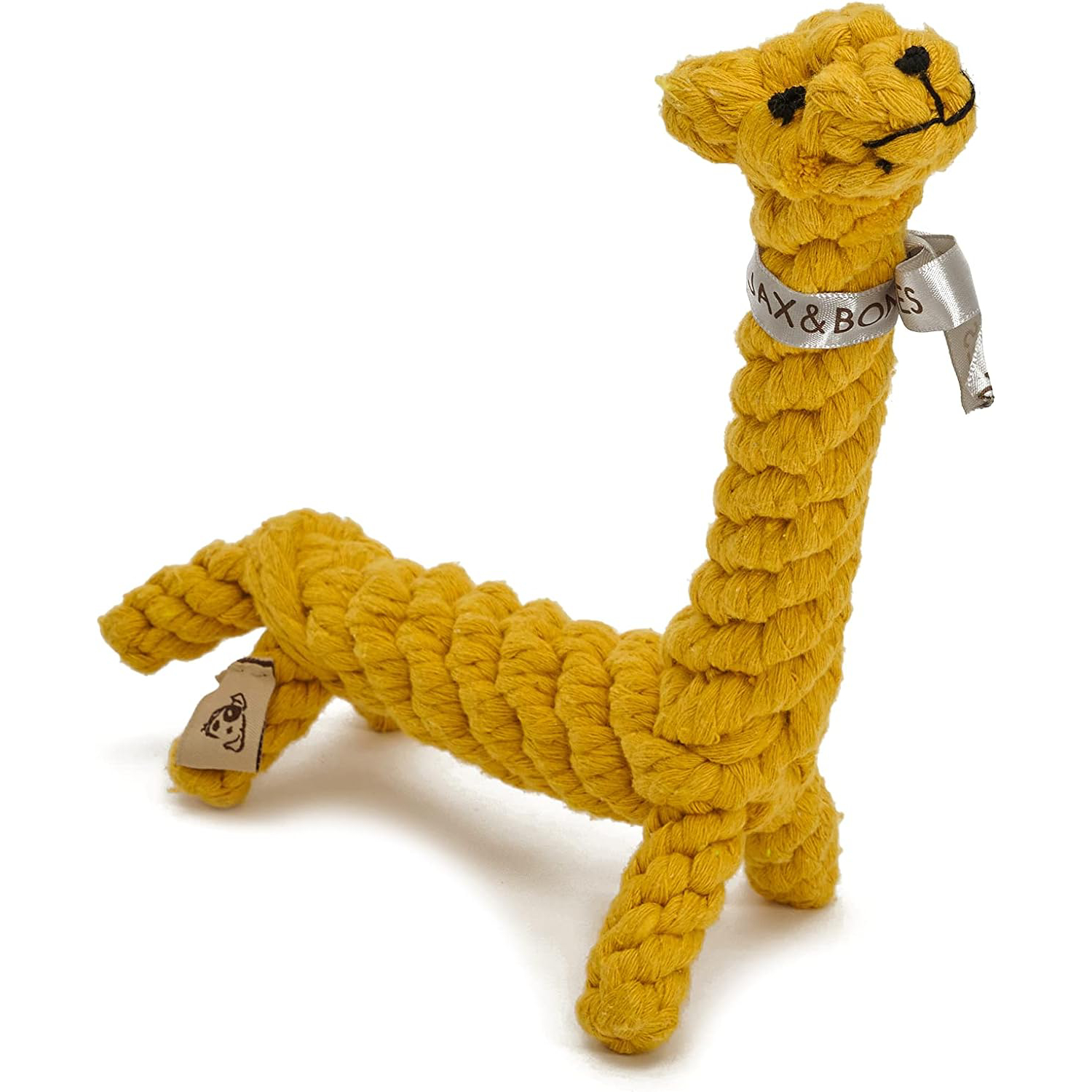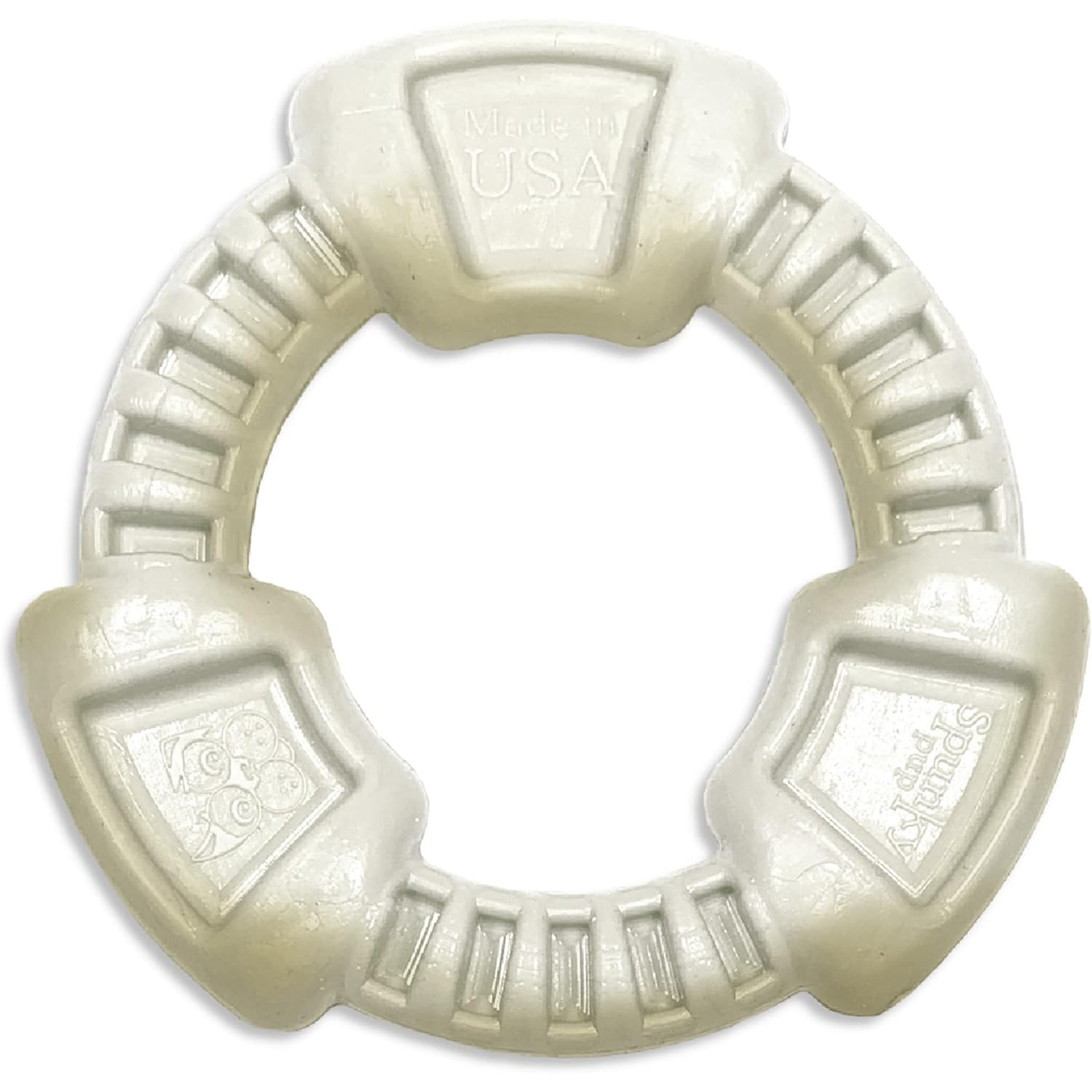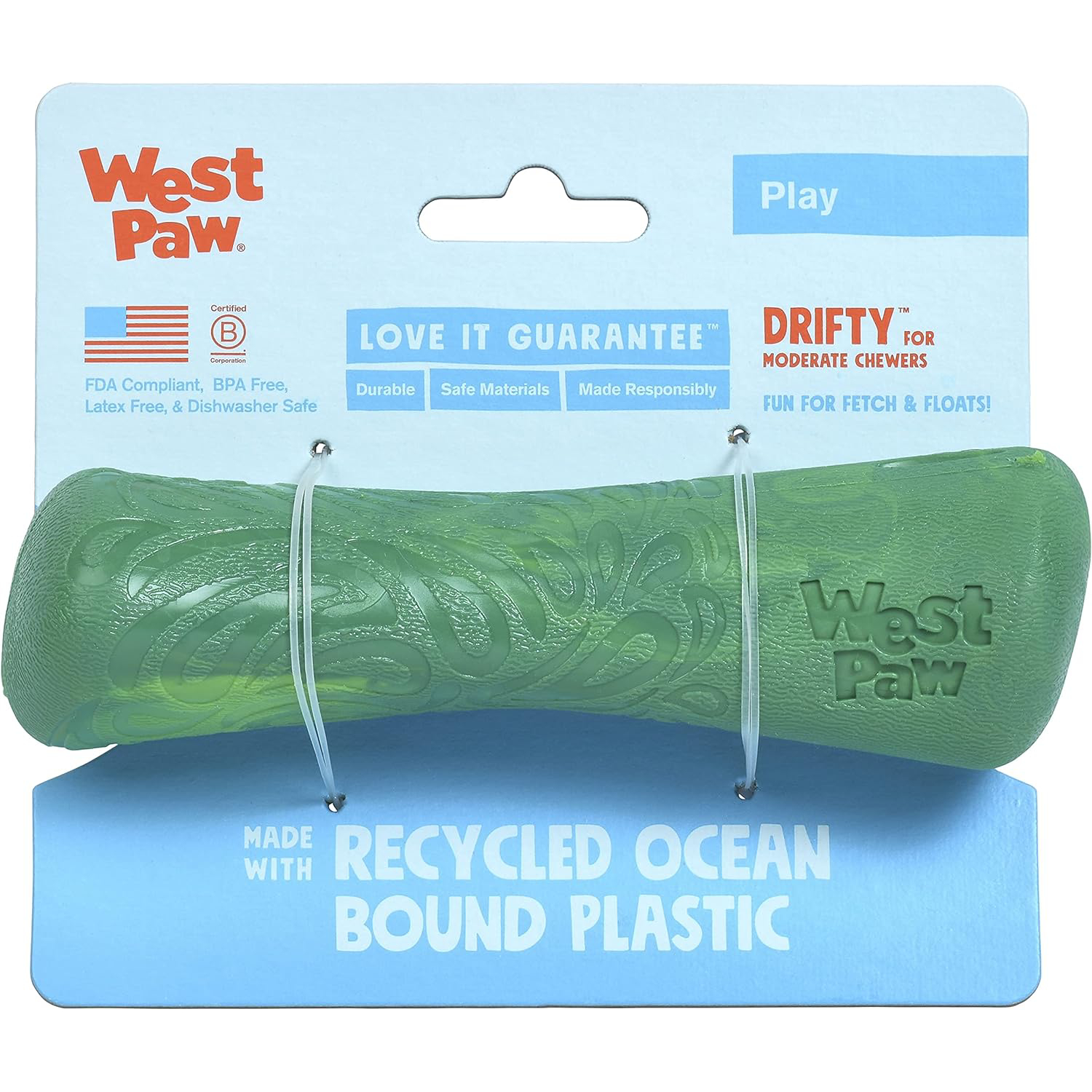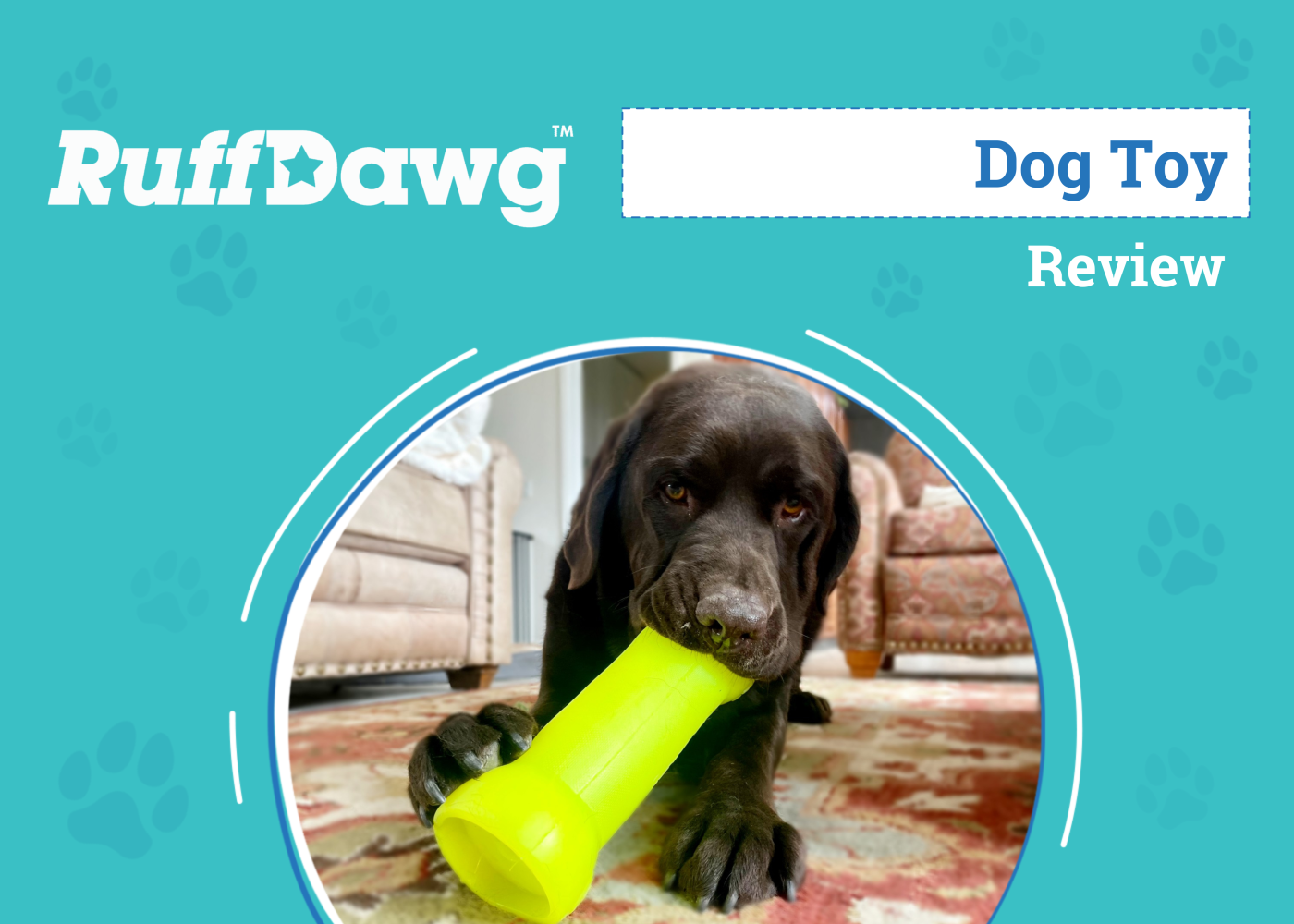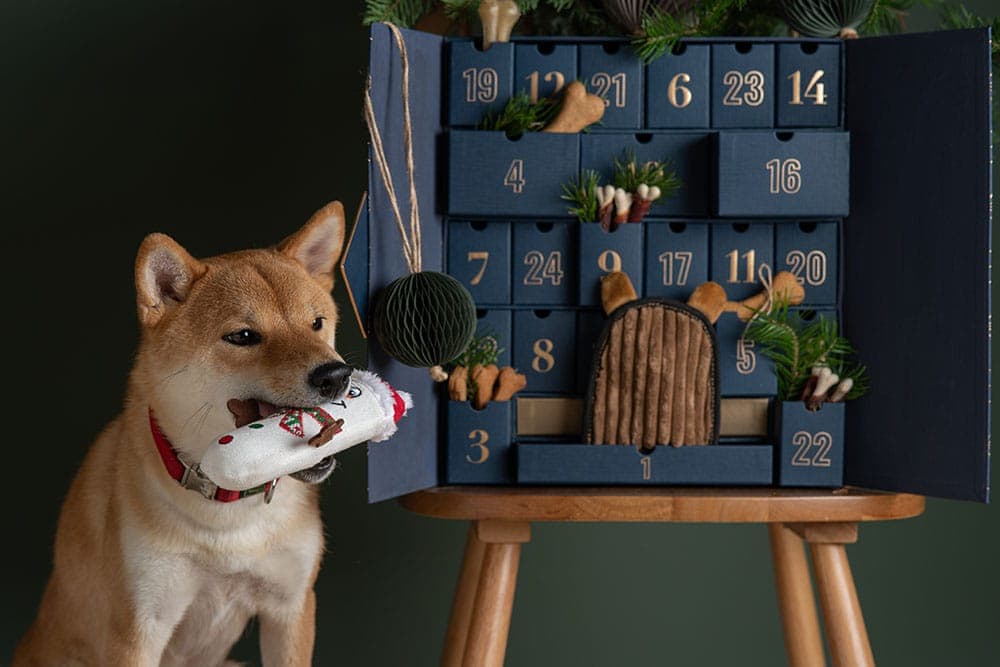
In this guide, we’ve selected 10 best eco-friendly dog toys based on consumer reviews to help you in your search. We’ll also list a buyer’s guide at the end to further explain what to look for to make the best purchasing decision.
A Quick Comparison of Our Favorites in 2024
| Rating | Image | Product | Details | |
|---|---|---|---|---|
| Best Overall |
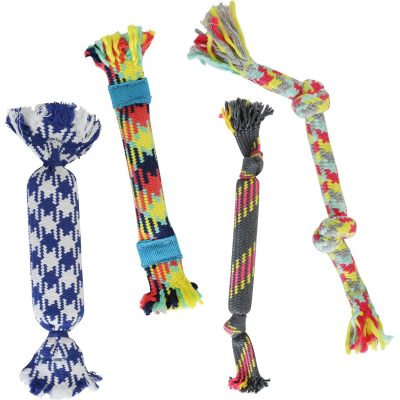
|
Rocket & Rex Rope Dog Toy Set |
|
CHECK PRICE |
| Best Value |
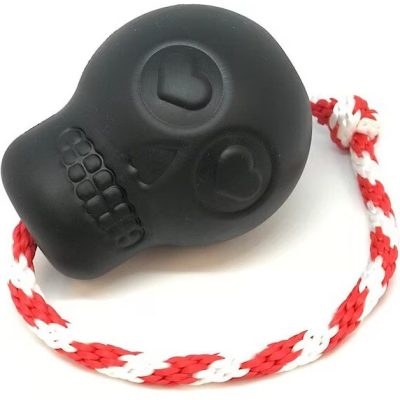
|
USA-K9 Magnum Skull Dog Chew Toy |
|
CHECK PRICE |
| Premium Choice |

|
BetterBone Tough Beef Dog Toy |
|
CHECK PRICE |

|
Earth-Rated Natural Rubber Dog Enrichment Toy |
|
CHECK PRICE | |
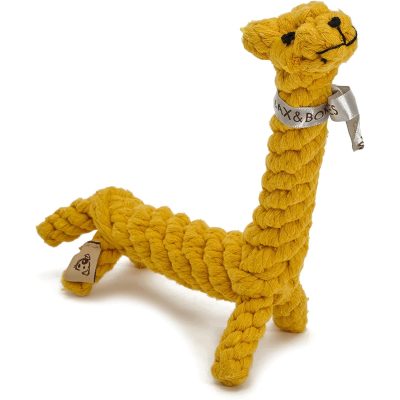
|
Jax and Bones Jerry The Giraffe Rope Dog Toy |
|
CHECK PRICE |
The 10 Best Eco-Friendly Dog Toys
1. Rocket & Rex Rope Dog Toy Set – Best Overall
| Material: | Cotton, rope, natural fabric |
| Breed size: | Small and medium breeds |
| Toy feature: | Variety pack |
The Rocket & Rex Not Just Your Plain Old Rope Dog Toy Set comes with four durable ropes of varying sizes made from cotton, rope, and natural fabric. It’s perfect for small to medium-sized breeds for a game of fetch or tuggy, and it helps support oral hygiene when your dog chews. The rope is non-toxic and includes rubber and crackle material inside for added fun and to encourage play.
A downside is that these ropes are not suited for heavy chewers and do not last as long as you’d like. Still, for the price, variety, and eco-friendly materials, this toy is the best overall eco-friendly dog toy.
- Comes with 4 ropes
- Made from all-natural materials
- Supports oral hygiene
- Not ideal for heavy chewers
2. USA-K9 Magnum Skull Treat Dispensing Tough Dog Chew Toy – Best Value
| Material: | Natural rubber |
| Breed size: | Medium breeds |
| Toy feature: | For tough chewers |
The USA-K9 Magnum Skull Treat Dispensing Tough Dog Chew Toy is an excellent eco-friendly toy made from all-natural rubber and is perfect for heavy chewers. It’s handy for a game of fetch and training, and it’s FDA-compliant and free from toxic materials for a safe option. The fun skull design is super durable, and you can hide treats inside for added fun. The rope allows you to play tug-of-war with your pooch, and the entire toy is biodegradable and dishwasher safe.
The rope is not the most durable and doesn’t seem to last long against heavy chewers. However, the skull is durable and can still be used, but you should throw the rope away once it frays for your dog’s safety. Given the skull’s durability and versatility, this toy is the best eco-friendly dog toy for the money.
- Made from all-natural rubber
- FDA-compliant
- Hide treats for stimulation
- Durable
- Dishwasher safe
- Rope doesn’t last long
3. BetterBone Tough Beef Dog Toy, Natural – Premium Choice
| Material: | Plant material, wood |
| Breed size: | Small breeds |
| Toy feature: | Splinter-resistant |
The BetterBone Tough Beef Dog Toy is made from all-natural, food-grade ingredients for an excellent eco-friendly option. It’s beef-flavored to entice your dog to chew, and it’s excellent for heavy chewers, especially given its splinter-resistant feature. It offers three different textures to support dental hygiene, and it’s super durable. In fact, this toy is roughly 5% to 10% harder than nylon, adding to its durability while reducing its carbon footprint.
The wood fibers are PEFC-certified and are sourced from sustainable forestry in Germany and Australia. Another main ingredient is plant-based vegetable oil made from sugar cane. It also comes in sustainable packaging.
Despite its durability, it may not hold up to heavy chewers, and the tiny pieces of the toy can become embedded in carpet or similar materials.
- All-natural, food-grade ingredients
- Excellent for heavy chewers
- Splinter resistant
- Supports dental hygiene
- PEFC-certified
- May not hold up with heavy chewers
- Tiny pieces may get embedded in carpet
4. Earth-Rated Natural Rubber Dog Enrichment Toy
| Material: | Natural rubber |
| Breed size: | All breed sizes |
| Toy feature: | Training |
The Earth-Rated Natural Rubber Dog Enrichment Toy is perfect for heavy chewers and is also handy for providing mental stimulation for puppies. You can add your pup’s favorite treats inside, such as xylitol-free peanut butter, yogurt, fruits, or veggies, and then freeze to provide hours of enrichment. It’s made from all-natural rubber and is dishwasher safe. This toy twists and rolls in unexpected ways for mental stimulation, and it’s reasonably priced.
Even though it’s made with heavy chewers in mind, no toy is indestructible, and this toy may not hold up well—if your dog pulls large chunks off, discard it for your puppy’s safety.
- Excellent for puppies for stimulation
- Made from all-natural rubber
- Reasonably priced
- May not hold up well
5. Jerry the Giraffe Rope Dog Toy
| Material: | Cotton, natural fabric |
| Breed size: | Large and giant breeds |
| Toy feature: | Aids in dental hygiene |
Jerry the Giraffe Rope Dog Toy by Jax and Bones is made from natural fabric and cotton, providing an affordable, 100% eco-friendly dog toy for your large pooch. This toy is 100% free from chemicals and toxic materials and uses all-natural vegetable dyes to keep your dog safe while playing. It is hand-tied for maximum strength, longevity, and durability.
The knotted texture of the toy acts as dental floss to keep your dog’s dental hygiene in check, and it is machine washable. You can also dip the toy in water and freeze it to offer your pup relief from sore gums or to help your dog cool down on hot days. Another plus is it’s biodegradable, meaning you can throw it in your compost pile when it’s time to discard it.
Despite its eco-friendly and durable status, this toy may not last long and will unravel quickly, especially with aggressive chewers and frequent play. Keep in mind that when the toy is shredded, you’ll need to discard it for your dog’s safety.
- 100% eco-friendly
- Uses all-natural vegetable dyes
- Great for dental hygiene
- 100% Biodegradable
- May unravel quickly
6. Creature ECO Organic Wool Ring Dog Toys – 2 Pack
| Material: | Organic wool |
| Breed size: | All breed sizes |
| Toy feature: | Natural and gentle texture |
Creature ECO Organic Wool Ring Dog Toys are made from 100% organic New Zealand wool and come in a pack of two. The manufacturer does not use synthetic materials, toxins, or plastics, and the natural texture is gentle on teeth and gums. What’s more, the manufacturer uses only 100% recycled materials that are safe for the environment, with algae used as ink on the boxes. The toys are either 4-inch or 6-inch in diameter, and the wool is durable yet lightweight.
You can hand-wash these toys with soap and water or simply throw them in the wash for easy cleaning. A con with these toys is the wool may produce fuzz in some cases, making some dogs cough when playing or chewing.
- 100% organic New Zealand wool
- Comes in a pack of 2
- Lightweight and durable
- Manufacturer uses 100% recycled materials
- No synthetic materials, toxins, or plastics
- May produce fuzz
7. Spunky Pup Clean Earth Recycled Ring Dog Toy
| Material: | 100% recycled water bottles |
| Breed size: | All breed sizes |
| Toy feature: | Heavy duty |
The Spunky Pup Clean Earth Recycled Ring Dog Toy is made from 100% recycled water bottles, and the toy itself is recyclable after use. It has a textured circular shape that makes it easy for your dog to grasp with his paws, and the added chicken flavoring entices your dog to chew and play. The texture also aids in supporting your pup’s dental hygiene. This eco-friendly toy measures 4 x 4 x 8 inches and is perfect for dogs of all sizes. It’s also dishwasher safe. It’s also made in the U.S.A.
Due to the 100% recycled plastic, it’s important to monitor your dog while chewing this toy. Your dog may swallow small pieces, which could cause gastrointestinal upset or even a blockage.
- Made from 100% recycled water bottles
- Textured circular shape
- Added chicken flavoring
- Dishwasher safe
- Not very durable
- Must monitor your dog while chewing
8. WEST PAW Seaflex Drifty Dog Toy
| Material: | Recycled plastic |
| Breed size: | Small and medium breeds |
| Toy feature: | 100% recyclable |
West Paw is dedicated to reducing an environmental footprint and has put much thought into producing responsibly made dog toys using only sustainable materials. Their WEST PAW Seaflex Drifty Dog Toy is shaped like a real bone and offers an eco-friendly, BPA-free, latex-free, and FDA-compliant toy. It’s 100% recyclable and perfect for moderate to heavy chewers. This toy is made from recycled ocean-bound plastic and is dishwasher safe. It’s easy to grab for a game of fetch, and your dog will enjoy chewing the toy, which helps maintain good oral health. It’s also made in the U.S.A.
Consumers love the design, but some are displeased with the materials, stating the toy doesn’t last long.
- BPA and latex-free
- FDA-complaint
- 100% recyclable
- Made from recycled ocean-bound plastic
- Dishwasher safe
- Toy doesn’t last long
9. KONG Classic Dog Toy
| Material: | Natural rubber |
| Breed size: | All breed sizes |
| Toy feature: | Excellent for heavy chewers |
The Kong is a classic, and we couldn’t leave it off our list, especially since it is made from all-natural rubber for an eco-friendly option. Kongs are wonderful for heavy chewers, as this toy is virtually indestructible. The Kong is also perfect for stuffing your dog’s favorite snack inside to provide mental stimulation. These toys bounce unpredictably, making playtime even more fun. Kong is proudly made in the U.S.A. and has been trusted to make toys using globally sourced materials for over 40 years.
The Kong comes in many sizes and suits dogs of all breeds and sizes. Remember that no toys are 100% indestructible, and a heavy chewer can tear one up. Some consumers also claim it has a chemical smell.
- Made from all-natural rubber
- Perfect for stuffing with treats
- Unpredictable bounce for play
- Made in the U.S.A.
- Not 100% indestructible
- Has a chemical smell
10. Natural Cotton Dog Rope Toys
| Material: | Dye-free cotton |
| Breed size: | Small and medium breeds |
| Toy feature: | 3-in-1 toy design |
Natural Cotton Dog Rope Toys are handmade from all-natural, dye-free cotton yarn for a safe, eco-friendly option. This toy also boasts a 3-in-1 play design with a handle area, bite zone, and tug strings to give your dog playtime versatility for playing tug-of-war, fetch, or simply chewing. This toy can help relieve stress and anxiety for your dog, and the durable, knotted construction allows for longevity. The manufacturer also uses recyclable packaging to keep everything eco-friendly, and this toy comes in a pack of two.
The only drawback we see is it may not last with aggressive, heavy chewers.
- 3-in-1 toy design
- Made from dye-free, natural cotton yarn
- Recyclable packaging
- Comes in a pack of 2
- May not last with heavy chewers

Buyer’s Guide: How to Choose an Eco-Friendly Dog Toy
Searching for an eco-friendly dog toy takes knowing what to look for to ensure the toy is, in fact, eco-friendly. To help you further, here are a few considerations before buying.
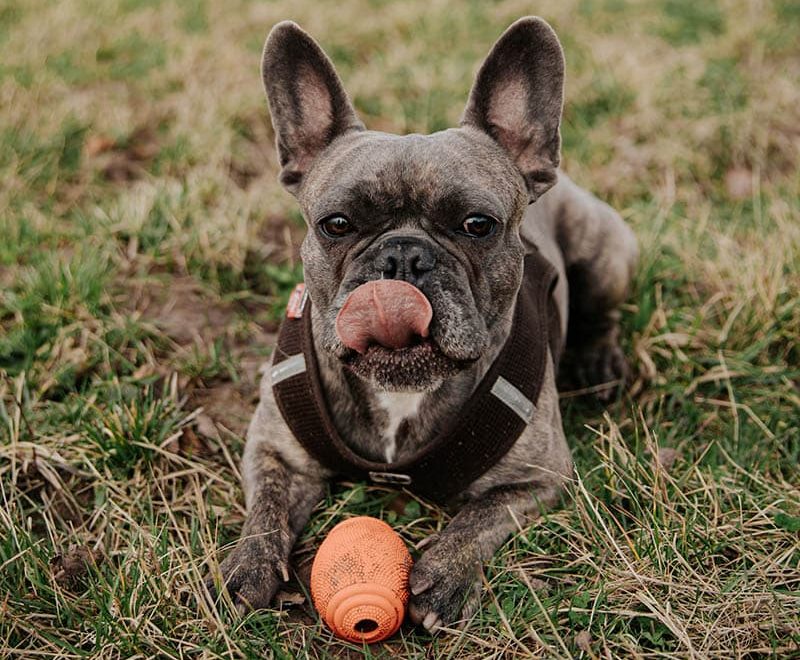
Materials
The biggest factor that makes a toy eco-friendly is the materials it is made of. You’ll want to look for sustainable materials like cotton, natural rubber, bamboo, wool, recycled plastics, recycled materials made from plants, or hemp. The toy should be free from toxic materials, chemicals, and dyes, and ideally, it should be biodegradable. Biodegradable materials break down more quickly without spreading harmful chemicals as they break down. They also do not take up a large amount of space in landfills as they break down.
Manufacture Packaging Practices
Some companies that make eco-friendly dog toys also use eco-friendly packaging material, which helps reduce the carbon footprint even further. If you’re looking to help the environment by purchasing eco-friendly dog toys, you might as well go that last little mile to ensure the packaging is recyclable. Plus, it allows you to feel confident that the toy you purchase from makes their toys with the environment in mind, even with packaging.

Materials to Avoid in Dog Toys
You should steer clear of non-sustainable materials like vinyl, non-recyclable plastics, unnatural dyes, toxins, and chemicals, as well as non-biodegradable materials. It’s important to note that dog toys are not regulated by any government organizations, so it’s up to you to ensure your dog’s safety with toys.
Toxins
We want to list certain toxins specifically so you know exactly what to avoid.
- BPA: BPA (Bisphenol A) is a chemical used in the manufacturing of synthetic plastics. BPA can be found everywhere, including our dog foods. Humans are even at risk for BPA exposure from foods and drinks stored in plastic containers.
- Phthalates: This is an additive often used in PVC products. Over time, it can be absorbed through your dog’s gums, potentially damaging the kidneys and liver.
- Lead: Lead can damage vital organs, including the nervous system and gastrointestinal tract. Note that some tennis balls (a dog favorite) may have lead contamination, so you may want to avoid giving your dog an old tennis ball to play with. Instead, provide a true, eco-friendly tennis ball that you know is lead-free.
Why Do Eco-Friendly Dog Toys Matter?
Eco-friendly dog toys matter because they leave less of a carbon footprint on our environment and are safer for your dog’s health. It’s estimated that over 600 million dog toys end up in U.S. landfills each year—that’s equivalent to over 40,000 tons of waste. Let’s face it: Dogs love to chew and destroy things, and non-eco-friendly toys make trash, leaving a negative impact on our environment. Not only that, but toys made from chemicals or ones that contain toxins are just plain bad for your dog’s health.
Think about this: toys made from non-recyclable plastics end up in landfills or, worse, in our oceans, wreaking havoc on our ecosystem. If we all play just a small part, such as buying eco-friendly dog toys, we can help save our planet.

Other Ways Dog Owners Can Be Eco-Friendly
Other ways to be an eco-friendly dog owner are to buy compostable poop bags. Compostable poop bags break down faster in landfills because they are made from plant starch and are plastic-free; they also dissolve faster in water.
Making your own dog toys is budget-friendly and easy. You can use eco-friendly materials like old socks, scrap fabric, or anything made of safe materials, like recycled plastics, hemp, wool, bamboo, etc. You can even make a tuggy toy by simply using an old cotton shirt.
What to Know About International Shipping
Knowing where the eco-friendly dog toy you purchased is coming from is also important to make a full, positive impact on the environment. If you purchase a dog toy made in China, the product has to make its way here, which adds a vast number of emissions during shipping. To truly reduce a carbon footprint, aim to purchase toys made right here in the U.S.
Conclusion
To conclude our reviews, the Rocket & Rex Rope Dog Toy Set is made from cotton, rope, and natural fabric and supports your dog’s oral hygiene, making it the best overall eco-friendly dog toy. For the best value, the USA-K9 Magnum Skull Treat Dispensing Tough Dog Chew Toy is made from all-natural rubber and is perfect for heavy chewers. It’s also FDA-compliant and allows you to hide treats inside for enrichment. Whichever you decide to go with, though, know that you are making a wise choice for your pup and your planet.
Featured Image Credit: Egrigorovich, Shutterstock
Contents
- A Quick Comparison of Our Favorites in 2024
- The 10 Best Eco-Friendly Dog Toys
- 1. Rocket & Rex Rope Dog Toy Set – Best Overall
- 2. USA-K9 Magnum Skull Treat Dispensing Tough Dog Chew Toy – Best Value
- 3. BetterBone Tough Beef Dog Toy, Natural – Premium Choice
- 4. Earth-Rated Natural Rubber Dog Enrichment Toy
- 5. Jerry the Giraffe Rope Dog Toy
- 6. Creature ECO Organic Wool Ring Dog Toys – 2 Pack
- 7. Spunky Pup Clean Earth Recycled Ring Dog Toy
- 8. WEST PAW Seaflex Drifty Dog Toy
- 9. KONG Classic Dog Toy
- 10. Natural Cotton Dog Rope Toys
- Buyer’s Guide: How to Choose an Eco-Friendly Dog Toy
- Materials
- Manufacture Packaging Practices
- Materials to Avoid in Dog Toys
- Toxins
- Why Do Eco-Friendly Dog Toys Matter?
- Other Ways Dog Owners Can Be Eco-Friendly
- What to Know About International Shipping
- Conclusion





